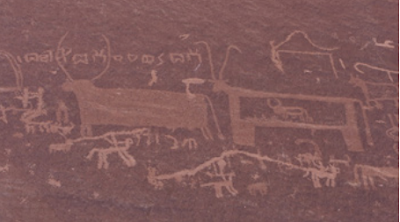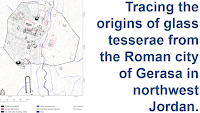Saudi Arabia covers an area of about 2 million km² with rock art known from every area of the country. A comprehensive survey of the rock art of Saudi Arabia begun in 1981 took over 15 years to complete, and recorded over 2000 sites with pre-Arabic and early Arabic inscriptions, as well as thousands of petroglyphs (images made by inscribing into a rock surface).
In a paper published in the Journal of Historical Archaeology and Anthropological Sciences on 3 July 2023, Majeed Khan and Faisal Al-Jabrin of the Antiquities Sector of the Saudi Ministry of Culture, describe a newly discovered rock art site at Wadi Bajdha in the Tabuk Region of Saudi Arabia, and discuss the implications of the images discovered there.
The art is located in a deep valley surrounded by mountains to the northwest of the city of Tabuk, where water collected during the rainy season. The site has historically been visited seasonally by Bedouin herders, and may have, at times, hosted permanent settlements.
The rock art is located on a vertical rock face on the side of a hill, which appears to contain images from different periods. The oldest figures on this panel appear to be a group of Cattle with short horns and flat humps. These Cows appear to be different from both the long-horned Oxen depicted at the Neolithic sites of Jubbah and Shuwaymis, and the high-humped Indian Zebu-like Cattle depicted in the Najran area of southern Saudi Arabia. Khan and Al-Jabrin suggest that this art represents the second phase of Cattle domestication in Saudi Arabia, following the Neolithic long-horned Oxen phase.
The rock art of Saudi Arabia is highly diverse, and appears to have been produced in a range of contexts with different purposes and meanings. Neolithic images appear to show Oxen as both Animals hunted as prey, and as sacred or possibly Divine Animals. Chalcolithic images have been interpreted to show Oxen as mythical creatures, deities, and sacrificial Animals. With this in mind, Khan and Al-Jabrin are careful to compare the Wadi Bajdha rock art to rock art from other locations, before drawing any conclusions about its meaning.
Archaeological evidence and rock art depictions both suggest that Wild Cattle, Bos primigenius, were present in Arabia as both wild and domestic Animals during the Neolithic. At sites such as Shuwaymis, Jubbah, Hanakiya, large numbers of Oxen are depicted, with flat backs and exaggerated horns. These resemble European Wild Cattle, Bos primigenius, an Animal not known after the Neolithic climate shift, which occurred about 7900 years ago in northern Arabia, and led to a shift from a cool, humid climate to a hot, arid one.
Petroglyphs of Cattle in Saudi Arabia represent at least three separate climatic phases, which each phase associated with images of different sizes, styles, and execution techniques, which has enabled the development of a chronology for such art, which links Animal type to climate shifts.
The style of the rock petroglyphs at Wadi Bajdha suggests that the art dates from the Chalcolithic Period, about 3500 BC. At this time people in the area had domesticated Cows and Goats, and engaged in small-scale hunting along with the hunting of Ibex. Camels did not appear in Arabia until the Bronze Age (along with Date Palms), and are absent from the Wadi Bajdha art.
The left corner of the Wadi Bajdha panel depicts a number of large, Chalcolithic-style Cows, as well as several Ibex, and some Horse riders with lances. These appear to have been made by artists from different periods, who took care not to overlap the art, as well as some tribal symbols. Battles between riders armed with lances was common among Bedouin tribes into the recent past.
The Wadi Bajdha art shows apparently domesticated Cattle, including a pregnant female with a baby inside, but no images of Camels, suggesting that this art is Chalcolithic in origin. The site is likely to have has good living conditions during this interval, supporting a permanent or semi-permanent population, who presumably left as the climate continued to get hotter and drier. Many other rock art sites in Saudi Arabia show similar combinations of Human and Animal figures, and appear to have been abandoned after short periods of occupation. This suggests that the population of Saudi Arabia has been largely nomadic for much of its history, inhabited by groups who moved regularly depending on the availability of water.
See also...
Follow Sciency Thoughts on Facebook.
Follow Sciency Thoughts on Twitter.
























































